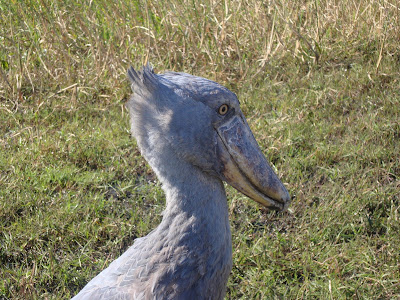Well there we were in the hills in the remote Bangweula Swamps when two little additions to the MacIntyre clan arrived and we only found out four days later as we entered an area with phone signal.
CONGRATULATIONS Al & Joy on the birth of your twins girls, Bella and Catlyn! Your adventures from this point on will be much more exciting than ours! Al, this is what your mum and dad looked like when they received the news, amazingly, via a phone call from Jess in York!
We seem to have settled into something of a pattern with one day of travelling and two or three days of staying in a camp. So far we have managed to find a camp every night which is great. They range from very basic with nothing more than a “long drop” to slightly more fancy with hot showers (African style, e.g. an overhead bucket filled with water heated by a wood fire). For the last two nights we have stayed in a camp at Kapycha which has a natural hot spring at 40 degrees Celcius. It was difficult to leave this place!
Bangweula Swamps was very special. It is a vast area of swamp land (10,000 square km) and is best
known for a rare prehistoric Dodo-like
looking bird called a Shoebill Stork. Only 60 are thought to still exist here and the only way to see it is to drive about four
hours from the park entrance to the swamp area on an almost impossible dirt road, then take a boat (not dis-similar to an Oxford punt!) for about an hour and
lastly walk through ankle to knee deep swamp water, depending on the season.
You then wait and hope for a sighting. Well we were lucky and even though neither Don
nor myself are knowledgeable of birds, this sighting was something really special.
Here is a picture of it.
The other species you only find in this region is an antelope called a Black Letchwe (as distinct from Red Letchwe which is found in South Africa). As you drive onto the plains immediately before arriving at the swamp land you suddenly see thousands (more like tens of thousands!) of them, another very special experience. We were lucky enough to have them cross right in front of us as we were in our boat and if we don’t make it to the wilderbeest migration, this will be the closest to it.
We have subsequently moved south and have just arrived in 'Buffalo camp' in the North Luangwa National Park which is only accessible from
March to September. The entire camp, which comprises eight reed huts, is under
water in the rainy season so each year the whole camp is re-built from scratch.
North Luangwa Park is in the Luangwa Valley which is part of the Great Rift
Valley of East Africa. The valley is estimated to be 175-300 million years old
and is considered to be one of the last “True Wildernesses” left in Africa.
 |








No comments:
Post a Comment